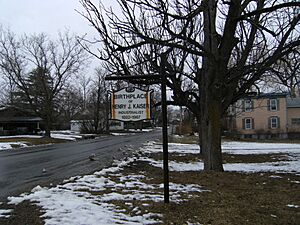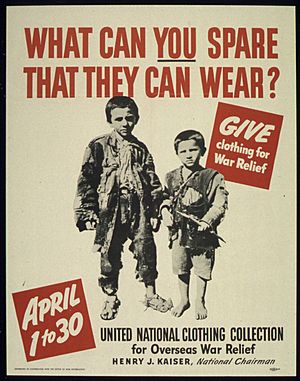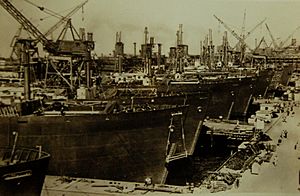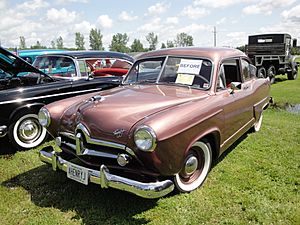Henry J. Kaiser facts for kids
Quick facts for kids
Henry J. Kaiser
|
|
|---|---|
 |
|
| Born |
Henry John Kaiser
May 9, 1882 Sprout Brook, New York, U.S.
|
| Died | August 24, 1967 (aged 85) Honolulu, Hawaii, U.S.
|
| Occupation | Industrialist, shipbuilder |
| Children | Edgar Kaiser, Sr Henry Kaiser, Jr. |
| Relatives | Edgar Kaiser, Jr (grandson) Henry Kaiser (grandson) |
Henry John Kaiser (May 9, 1882 – August 24, 1967) was a famous American businessman. He was known as the "father of modern American shipbuilding" because he found new ways to build ships very quickly. Before World War II, Kaiser worked in construction. His company helped build the huge Hoover Dam.
During World War II, he created the Kaiser Shipyards. These shipyards built many Liberty ships, which were cargo ships needed for the war. After the war, he started companies like Kaiser Aluminum and Kaiser Steel. Henry Kaiser also cared about his workers. He started Kaiser Permanente, a healthcare system for his employees and their families. He even made cars with Kaiser-Frazer and Kaiser Motors, which were known for being safe. Kaiser also built big projects like civic centers and dams. He invested in real estate and later got into television. With his money, he created the Kaiser Family Foundation, a charity focused on health.
Contents
Early Life and First Businesses
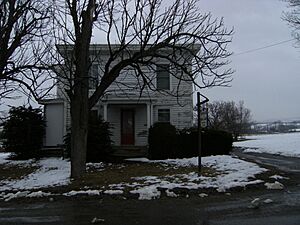
Henry Kaiser was born on May 9, 1882, in Sprout Brook, New York. His parents, Franz and Anna Marie Kaiser, were immigrants from Germany. His father was a shoemaker. When Henry was 16, he got his first job as a "cash boy" in a department store.
Later, he became a photographer's helper. By age 20, he was running his own photography studio in Lake Placid, New York. He saved his money and moved to Washington state in 1906. There, he started a construction company that worked on government projects.
Henry met his future wife, Bess Fosburgh, at his photography shop. Her father wanted to make sure Henry was financially stable before they married. So, Henry moved to Spokane and became a top salesman at a hardware company. Ten months later, he had enough money. They married on April 8, 1907, and had two sons, Edgar Kaiser, Sr and Henry Kaiser, Jr.
In 1914, Kaiser started a paving company called Henry J. Kaiser Co., Ltd. This company was one of the first to use large construction machines. His business grew a lot in 1927 when it won an $18-million contract to build roads in Cuba. In 1931, his company was one of the main builders of the Hoover Dam on the Colorado River. After that, they also built the Bonneville and Grand Coulee Dams on the Columbia River.
While working with a group of companies called "Six Companies, Inc.," Kaiser also started shipyards in Seattle and Tacoma. He began using new ways to build ships quickly, like using welding instead of rivets.
World War II Contributions
Henry Kaiser believed in helping those affected by the war in Europe. In 1940, even before the U.S. joined World War II, Kaiser led a national effort. This effort collected clothing for people who had to leave their homes because of Hitler's actions in Europe.
Kaiser Shipbuilding
Kaiser fought Hitler more directly with his famous Kaiser Shipyard in Richmond, California. During World War II, he changed how ships were built. He made it possible to build large cargo ships in about 45 days. These ships were called Liberty ships. Later, he also built faster Victory ships.
Kaiser became world-famous when his teams built a ship in just four days! The SS Robert E. Peary, a 10,500-ton ship, started being built on November 8, 1942. It was ready to launch from the Richmond Shipyard #2 on November 12, just four days and 15 and a half hours later. The old record was ten days.
One of Kaiser's team members visited a Ford factory. This visit led to the idea of using welding instead of riveting for shipbuilding. Welding was better because it needed less strength. It was also easier to teach to thousands of new workers, many of whom were women and had no prior experience. Kaiser also started using "sub-assemblies." This meant building parts of the ship separately and then putting them together. This made building ships much faster and more organized.
Other Kaiser shipyards were in Vancouver, Washington, and Portland, Oregon. One smaller ship was built in only 71 hours and 40 minutes! Kaiser's ship designs also became America's smaller aircraft carriers, called "escort carriers." More than 100 of these were used in both the Pacific and Atlantic during the war. The ideas Kaiser developed for building ships quickly are still used today.
There was a problem with some early welded ships: they could crack in cold seas. This was called "brittle fracture." Scientists later figured out why this happened. Small changes in design and better welding rules fixed the problem by 1947. Kaiser also played a big part in the Joshua Hendy Iron Works. This company built the engines for the Liberty ships.
Kaiser Permanente Healthcare
At his shipyards in Richmond, California, Kaiser started a new idea for healthcare. He worked with Dr. Sidney Garfield to create Kaiser Permanente. On August 10, 1942, the Kaiser Richmond Field Hospital opened. It was paid for by the U.S. government and Kaiser's own foundation. Dr. Garfield ran it.
The hospital started with only 10 beds. By 1944, it grew to 160 beds. This hospital was part of a three-part medical system. It included first aid stations at the shipyards and a main hospital in Oakland for serious cases. By August 1944, most Richmond shipyard workers had joined Kaiser Permanente. It was the first large group health plan in the country. After the war, the plan was expanded to include workers' families. Kaiser opened more Permanente facilities in other places to serve his many businesses. Today, the Kaiser family is no longer connected to Kaiser Permanente.
Postwar Businesses
Kaiser Automobiles
Kaiser-Frazer
In 1945, Kaiser teamed up with Joseph Frazer, an experienced car executive. They started a new car company called Kaiser-Frazer. They used a large factory in Michigan that Ford Motor Company had used to make aircraft during the war. Kaiser-Frazer (later called Kaiser Motors) made cars under the Kaiser and Frazer names. They stopped making cars in the U.S. in 1955 and moved production to Argentina.
Henry J.
The Henry J was a car built by the Kaiser-Frazer Corporation. It was named after Henry J. Kaiser himself. Production of the six-cylinder models began in July 1950. The four-cylinder models started shortly after. The car was officially introduced to the public on September 28, 1950. It was sold until 1954. There was even a contest to name the new car, and "Henry J" was chosen.
Jeep and South America
In 1953, Kaiser bought Willys-Overland, the company that made the Jeep vehicles. He changed its name to Willys Motors. In the late 1960s, Kaiser sold his South American car operations. In 1963, the company's name changed again to Kaiser-Jeep. This company was eventually sold to American Motors Corporation in 1970.
Kaiser Aluminum
Kaiser started Kaiser Aluminum in 1946. He leased and later bought aluminum factories in Washington state from the U.S. government. Kaiser Aluminum grew into a full aluminum company. It mined and refined bauxite (the raw material), produced aluminum, and made finished aluminum products.
Kaiser Family Foundation
In 1948, Kaiser created the Henry J. Kaiser Family Foundation. This is a U.S.-based, non-profit organization that focuses on healthcare issues. It was first in Oakland and later moved to Menlo Park, California. When Kaiser died, half of his money went to this foundation. The Foundation is not connected to Kaiser Permanente or Kaiser Industries. It works independently to provide facts and analysis about healthcare to leaders, health groups, and the public.
Real Estate Investments
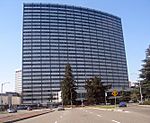
Henry Kaiser was also a big real estate developer. He founded the community of Hawaiʻi Kai in Hawaiʻi. Kaiser also helped develop Panorama City, a planned community in Los Angeles. Schools in Hawaii, West Virginia, and California are named after him.
Hawaii Village Hotel
Kaiser spent many of his later years in Honolulu. He loved making the city better. He built the Kaiser Hawaiian Village Hotel, which is now called the Hilton Hawaiian Village. He even used bright pink Jeeps to transport guests around the resort! Kaiser also built one of the first practical geodesic domes in the U.S. at this resort and used it as a theater.
Television Ventures
In the mid-1950s, Kaiser believed that television could help people learn about Kaiser products. In 1957, he worked with Warner Brothers and ABC to sponsor the TV show Maverick. This helped promote products like Kaiser aluminum foil and Kaiser Jeep vehicles. To support his Hawaii businesses, Kaiser also encouraged Warner Brothers to create a new TV show called Hawaiian Eye. This show featured private detectives based at Kaiser's Hilton Hawaiian Village. Kaiser eventually bought and built a chain of radio and television stations called Kaiser Broadcasting.
Personal Life and Death
Kaiser's first wife, Bess Fosburgh, passed away on March 14, 1951. Henry Kaiser then married Alyce Chester, the nurse who had cared for Bess, on April 10, 1951. He adopted her son, Michael. In 1955, Kaiser moved his family to Hawaii.
On August 24, 1967, Henry Kaiser died at age 85 in Honolulu. He is buried in Mountain View Cemetery in Oakland, California.
He was survived by his second wife, Alyce Chester Kaiser, who inherited half of his money. His elder son, Edgar F. Kaiser, had been the president of Kaiser Industries Corporation since 1956.
One of Kaiser's grandsons, Edgar Kaiser Jr., became president of Kaiser Steel and briefly owned the Denver Broncos football team. Another grandson, Henry, is a musician and diver.
Legacy and Recognition
Henry Kaiser helped build many important things like civic centers, roads, and schools. He was part of the group that built the Hoover Dam and Grand Coulee Dam. Kaiser is also remembered for improving medicine by building hospitals and medical centers. The mining town of Eagle Mountain, California, used Kaiser Permanente early on.
A class of 18 United States Navy ships, built in the 1980s and 1990s, is named the Henry J. Kaiser class. The first ship in this class, USNS Henry J. Kaiser, was named after him and started service in 1986.
In 1990, Kaiser was added to the Labor Hall of Fame in Washington, D.C. On December 1, 2009, Governor Arnold Schwarzenegger inducted Kaiser into the California Hall of Fame in Sacramento.
See also
 In Spanish: Henry John Kaiser para niños
In Spanish: Henry John Kaiser para niños
- KaiserAir, an airline and charter company that came from Kaiser Steel


